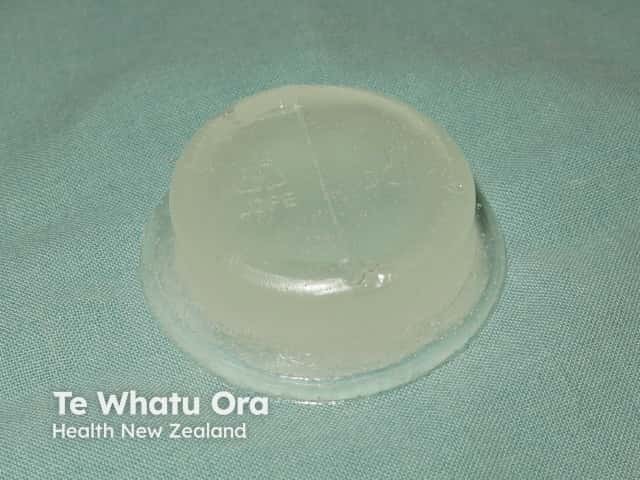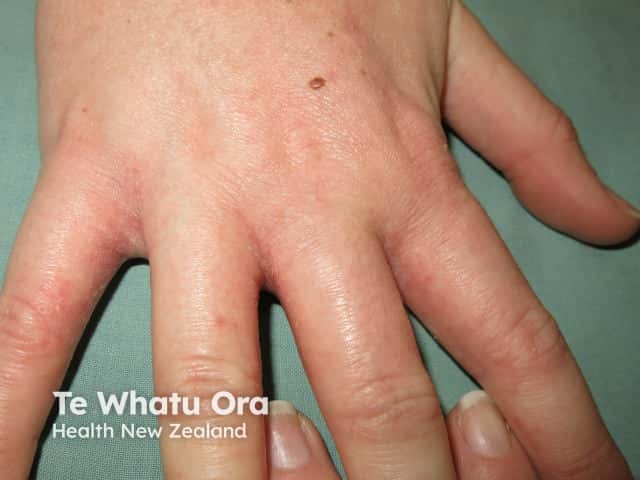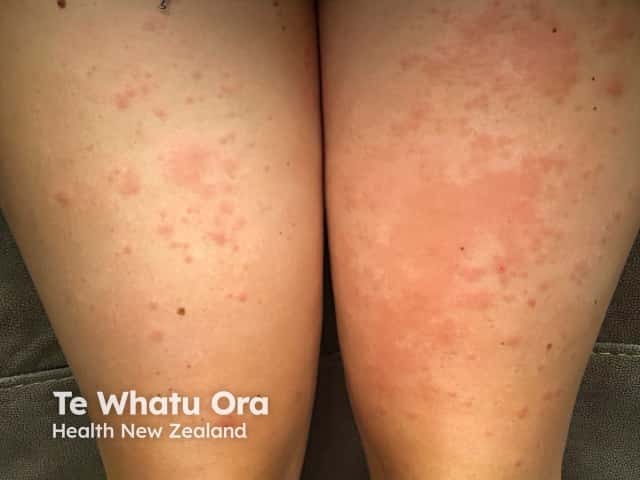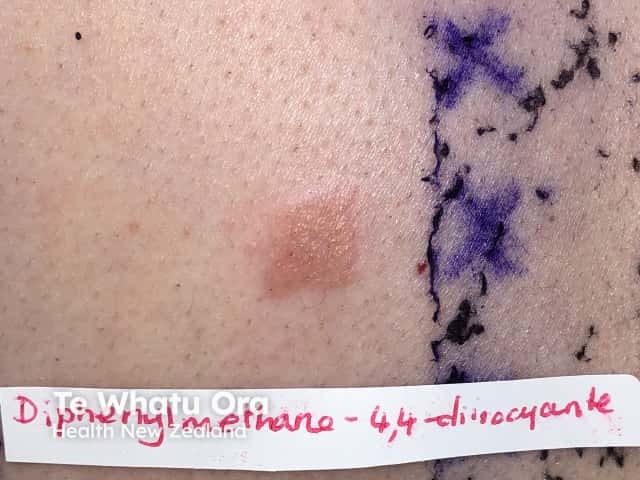Main menu
Common skin conditions

NEWS
Join DermNet PRO
Read more
Quick links
Allergic contact dermatitis to isocyanate — extra information
Allergic contact dermatitis to isocyanate
Authors: Dr Nicholas Manuelpillai, Dermatology Resident, St Vincent’s Hospital, Melbourne, VIC, Australia; A/Prof. Rosemary Nixon, Dermatologist, Occupational Physician and Director; Skin Health Institute, Melbourne, VIC, Australia. DermNet Editor in Chief: Adjunct A/Prof. Amanda Oakley, Dermatologist, Hamilton, New Zealand. Copy edited by Gus Mitchell. March 2020.
Introduction Demographics Causes Clinical features Diagnosis Treatment
What is allergic contact dermatitis to isocyanate?
An isocyanate is an organic compound used in the production of polyurethane foams, resins, coatings, and adhesives. The major commercial isocyanates are 4,4’-diphenylmethane diisocyanate (MDI) and 2,4-toluene diisocyanate (TDI), which account for more than 95% of global isocyanate production.
Isocyanates are considered potent respiratory allergens and are a leading cause of occupational asthma. Inhalation has long been considered the primary route of isocyanate exposure and sensitisation. Isocyanate exposure can also cause allergic contact dermatitis and irritant contact dermatitis.
The use of less volatile compounds and improvement in hygiene practices and use of personal protective equipment has increased the relative importance of skin exposure as a route of isocyanate exposure and sensitisation.

Resin containing isocyanate

Resin containing isocyanate
Who gets allergic contact dermatitis to isocyanate?
The groups most at risk of allergic contact dermatitis are those involved in the manufacture of isocyanate or polyurethane foam. Others include:
- Process workers
- Painters (particularly those in automobile repair)
- Carpenters
- Mechanics
- Textile workers
- Metallurgists
- Those working in the adhesive, automobile, chemical, or plastics industries.
What causes allergic contact dermatitis to isocyanate?
Workplace exposures can occur in the form of isocyanate vapours (resulting in airborne contact dermatitis), aerosols, or both. Exposure routes include inhalation, ingestion, skin, or eye contact. Skin exposure can occur through direct contact or failure of personal protective equipment (PPE).
Skin exposure to isocyanate initiates hapten-induced contact hypersensitivity resulting in a type IV hypersensitivity reaction, resulting in allergic contact dermatitis. However, the complete immunological mechanisms of sensitisation for isocyanate and other low-molecular-weight sensitisers are not completely understood, as exposure can result in multiple hypersensitivity pathways.
What are the clinical features of allergic contact dermatitis to isocyanates?
Exposure to isocyanate can result in allergic contact dermatitis, irritant contact dermatitis, contact urticaria, and generalised urticaria. Isocyanate-induced allergic contact dermatitis often presents with mild symptoms and the cause may be easily missed.
Most patients experience mild erythema, pruritus, and vesicular dermatitis on exposed sites, such as hands, forearms, and face. Exposure to isocyanate through the skin can induce respiratory sensitisation, with subsequent inhalation causing asthma.

Hand dermatitis

Hand dermatitis

Contact dermatitis due to isocyanate
How is allergic contact dermatitis to isocyanate diagnosed?
Detailed clinical history and examination are crucial, determining which sites of the skin are affected by dermatitis and whether there are any systemic features, such as coughing, dyspnoea, and wheezing.
Commercial patch testing preparations of isocyanate are available, but are known to be unreliable and unstable leading to the possibility of false-negative results. Patch test reactions to MDI have been reported to appear late after 7 days. A final reading on day 7 is therefore advisable.
When occupational allergic contact dermatitis to isocyanate is suspected, the specific isocyanates contacted at work should be tested in addition to commercial patch testing preparations.
Positive reactions to diaminodiphenylmethane (MDA) should be noted, as it may be an important marker for MDI sensitivity.

Patch test to isocyanate
What is the treatment for allergic contact dermatitis to isocyanate?
Prevention of contact both by inhalation and skin contact in people exposed to isocyanate is critical. Engineering controls such as closed systems and ventilation and PPE to prevent skin exposure are important measures to be taken at workplaces utilising isocyanates.
Nitrile gloves are preferable to latex gloves, but isocyanates may penetrate both types of glove. Polyvinyl alcohol chemical-resistant gloves or multi-laminate gloves (Ansell™ Barrier™, Silver Shield/4H™) are likely to provide the best hand protection.
Skin contaminated with isocyanate should be washed with water, followed by an application of 30% isopropyl alcohol before washing again with soap and water.
Contact dermatitis is treated with topical steroids, moisturisers and barrier creams, however systemic treatment is sometimes required using oral corticosteroids or immunosuppressive drugs.
References
- Bello D, Herrick CA, Smith TJ, et al. Skin exposure to isocyanates: reasons for concern. Environ Health Perspect. 2007;115(3):328-35. doi:10.1289/ehp.9557. PubMed Central
- Wenk KS, Ehrlich A. Isocyanates. Dermatitis. 2012;23(3):130-1. doi:10.1097/DER.0b013e31824a648d. Journal
- CDC. Methylene bisphenyl isocyanate: The National Institute for Occupational Safety and Health (NIOSH); 2018. Available from: www.cdc.gov/niosh/npg/npgd0413.html. Updated 2018-03-28.
- AIHW. Occupational asthma affects thousands: Australian Institute of Health and Welfare; 2008. Available from: www.aihw.gov.au/news-media/media-releases/2008/may/occupational-asthma-affects-thousands
- Shane HL, Long CM, Anderson SE. Novel cutaneous mediators of chemical allergy. J Immunotoxicol. 2019;16(1):13-27. doi:10.1080/1547691X.2018.1515279. PubMed
- Elsner P, John S-M, Maibach HI, Rustemeyer T. Kanerva's occupational dermatology, 2nd edn, Berlin, Heidelberg: Springer Berlin Heidelberg, 2012.
- Burrows D, Houle M-C, Holness DL, DeKoven J, Skotnicki S. Patch testing custom isocyanate materials from the workplace. Dermatitis. 2015;26(2):94-8. doi:10.1097/DER.0000000000000104. PubMed
- Goossens A, Detienne T, Bruze M. Occupational allergic contact dermatitis caused by isocyanates. Contact Dermatitis. 2002;47(5):304-8. doi:10.1034/j.1600-0536.2002.470509.x. PubMed
- Frick M, Zimerson E, Karlsson D, et al. Poor correlation between stated and found concentrations of diphenylmethane-4,4'-diisocyanate (4,4'-MDI) in petrolatum patch-test preparations. Contact Dermatitis. 2004;51(2):73-8. doi:10.1111/j.0105-1873.2004.00404.x. PubMed
- Frick-Engfeldt M, Isaksson M, Zimerson E, Bruze M. How to optimize patch testing with diphenylmethane diisocyanate. Contact Dermatitis. 2007;57(3):138-51. doi:10.1111/j.1600-0536.2007.01197.x. PubMed
On DermNet
- Allergic contact dermatitis
- Irritant contact dermatitis
- Contact dermatitis
- Contact allergens
- Eczema, dermatitis and allergies
- Patch tests
- Occupational skin diseases
- Personal protective equipment
Other websites
- Guide to Handling Isocyanates — Safe Work Australia
- Isocyanates — The National Institute for Occupational Safety and Health
- Isocyanates — Occupation Safety and Health Administration (OHSA)
